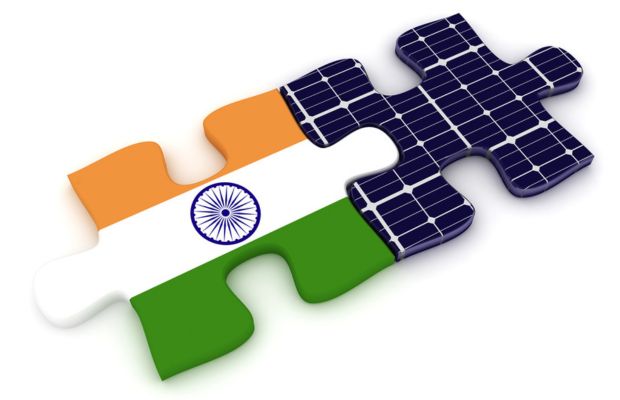Highlights :
- Share of non-fossil fuel in the total electricity production in 2022-23 and the current year (up to May 2023) was 25.44% and 22.45%
- India became the fourth-largest economy in terms of installed capacity of renewable energy in the world
 India's Top Ten Solar Module Manufacturers Based on AISMA List
India's Top Ten Solar Module Manufacturers Based on AISMA List India has come a long way from its fossil fuel-based economy to becoming the nation with the fourth-largest installed capacity of renewable energy in the world. Coal and oil have so far served as the bedrock of India’s industrial growth and modernisation, giving a rising number of Indian people access to modern energy services. This includes adding new electricity connections for 50 million citizens each year over the past decade. However, in recent years, the country has been a major contributor to renewable energy capacity addition.
Picture of Renewable India
India has set ambitious targets for 2030, with the headline numbers being installation of 500 gigawatts (GW) of installed electricity capacity from non-fossil sources by the deadline year. In addition, the nation aims to achieve about 50 per cent cumulative electric power installed capacity from non-fossil fuel-based energy resources by 2030. reducing the emissions intensity of its economy by 45 per cent, and reducing a billion tonnes of Carbon Dioxide (CO2).
The installed renewable energy capacity in India has increased from 115.94 GW in March 2018 to 172.00 GW in March 2023, i.e., an increase of around 148 per cent in the last half-decade. Central Electricity Authority (CEA) states that India generated about 365.60 Billion Units (BU) of electricity from renewable energy sources during the year 2022-23.
Furthermore, out of the targeted 500 GW by 2030, the country has a total of 176.49 GW of renewable energy capacity already installed, as on June 30, 2023. In addition to that, about 88.81 GW of capacity is under implementation and 51.43 GW of capacity is in the tendering stage. These numbers of course include large Hydro too, which was not included earlier in government calculations.
Declining Share of Fossil-fuel Power
The share of emissions causing fossil fuels has decreased over the years with non-fossil fuel share witnessing a surge. The Union Minister for New & Renewable Energy and Power recently informed that the share of non-fossil fuel in the total electricity production during the year 2022-23 and the current year (up to May 2023) was 25.44 per cent and 22.45 per cent respectively. The share of non-fossil fuel based capacity (including hydro) of India was 43 per cent, as of May 31, 2023.
Thanks to India’s policies targeting an accelerated energy transition, the share of non-fossil fuel based capacity is expected to make a meteoric rise, especially by the end of the current decade.
According to the National Electricity Plan (Generation Volume I), the proportion of non-fossil fuel capacity is projected to rise to 57.4 per cent by the conclusion of 2026-27, with further growth anticipated to reach 68.4 per cent by the end of 2031-32. Moreover, the share of gross generation is expected to increase to 39 per cent by 2026-27 and is likely to reach 49 per cent by 2031-32.
Efforts for Renewable Growth
The present trend of renewable growth is a direct result of government interventions, which form the most critical aspect of any country’s renewable growth. Some of the key initiatives include allowing Foreign Direct Investment (FDI) of up to 100 per cent through the automatic route, exempting Inter State Transmission System (ISTS) charges for the interstate sale of solar and wind power projects commissioned by 30th June 2025, establishing a trajectory for Renewable Purchase Obligation (RPO) up to the year 2029-30, and setting up Ultra Mega Renewable Energy Parks to offer land and transmission facilities to developers for large-scale renewable energy projects.
Additionally, various schemes have been introduced, such as Pradhan Mantri Kisan Urja Suraksha evam Utthaan Mahabhiyan (PM-KUSUM), Solar Rooftop Phase II, 12000 MW CPSU Scheme Phase II, and more. The government is also working on expanding the transmission network and creating new sub-station capacity under the Green Energy Corridor Scheme to ensure efficient evacuation of renewable power.
To establish clear guidelines and standards, the Government has issued notifications for the deployment of solar photovoltaic systems and devices, and standard bidding guidelines for tariff-based competitive bidding processes for the procurement of power from grid-connected solar PV and wind projects.
To ensure timely payment to renewable energy generators, the Government has mandated that power shall be dispatched against a Letter of Credit (LC) or advance payment by distribution licensees. Furthermore, the Government has introduced the Electricity (Late Payment Surcharge and related matters) Rules (LPS rules) and notified the Promoting Renewable Energy through Green Energy Open Access Rules 2022 (GOAR).
In a step towards advancing renewable energy markets, the Government has launched the Green Term Ahead Market (GTAM), facilitating the sale of renewable energy power through exchanges.
Lastly, the Government has introduced the National Green Hydrogen Mission with a vision to position India as a global hub for the production, utilization, and export of Green Hydrogen and its derivatives, emphasizing the commitment to a sustainable and green energy future.
RE Projects Everywhere
The positive atmosphere around renewable projects in India created by numerous factors mentioned earlier caused many mega projects to pop up across the country. This includes some of the mega projects like Bhadla Solar Park, a solar facility that covers an area of 14000 acres, and boasts a mammoth capacity of 2.25 GW.
More recently, a new project has been approved for setting up 624 circuit kilometres (ckm) of transmission lines and 2200 MVA capacity substations by FY 2025-26, for evacuation of renewable energy power of approx. 4000 MW capacity in the state of Tamil Nadu, under Green Energy Corridor Phase-II. The project has been approved by the Ministry of New & Renewable Energy, at an estimated cost of Rs. 719.76 crore and is under the process of implementation by the state agency Tamil Nadu Transmission Corporation Limited (TANTRANSCO).
Under Green Energy Corridor Phase-I, TANTRANSCO reported the completion of the sanctioned project for setting up 1068 ckm transmission lines and 1910 MVA capacity substations on October 31, 2022.
In addition to existing renewable projects, novel ventures in the renewable energy sector have emerged. On October 9, 2022, Indian Prime Minister Narendra Modi inaugurated India’s pioneering ‘Suryagram – Modhera’, the nation’s first Battery Storage and Solar Power-based facility in Gujarat. This project aims to provide a round-the-clock renewable power supply, marking a significant milestone in India’s renewable energy landscape. The project also includes a 6 MW ground-mounted solar power plant with a 15 MWh Battery Energy Storage System and Rooftop Solar systems on all feasible household and Government buildings, providing solar power to the entire Modhera village, which has a population of around 6,500 people.






























